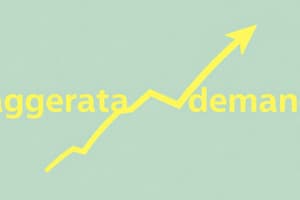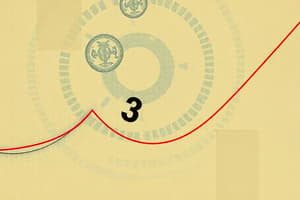Podcast
Questions and Answers
Assuming a closed economy, how would a simultaneous and unanticipated technological innovation in both the consumer goods and capital goods sectors most likely affect the aggregate supply curve?
Assuming a closed economy, how would a simultaneous and unanticipated technological innovation in both the consumer goods and capital goods sectors most likely affect the aggregate supply curve?
- Both the short-run aggregate supply (SRAS) and the long-run aggregate supply (LRAS) curves shift rightward. (correct)
- The short-run aggregate supply (SRAS) curve remains unchanged, and the long-run aggregate supply (LRAS) curve shifts leftward.
- The short-run aggregate supply (SRAS) curve shifts rightward, and the long-run aggregate supply (LRAS) curve remains unchanged.
- The short-run aggregate supply (SRAS) curve shifts leftward, and the long-run aggregate supply (LRAS) curve shifts rightward.
In an open economy operating under a floating exchange rate regime, a sudden and significant increase in domestic labor productivity, all else being equal, would most likely lead to which of the following?
In an open economy operating under a floating exchange rate regime, a sudden and significant increase in domestic labor productivity, all else being equal, would most likely lead to which of the following?
- A depreciation of the domestic currency due to decreased net exports, offsetting any gains from increased aggregate supply.
- A depreciation of the domestic currency as a result of decreased foreign investment, causing a rightward shift in the aggregate demand curve.
- An appreciation of the domestic currency due to increased net exports, leading to a leftward shift in the aggregate demand curve. (correct)
- An appreciation of the domestic currency due to increased capital inflows, further stimulating aggregate demand beyond the initial productivity gain.
Considering a scenario where a country's central bank credibly announces a future increase in the inflation target, how would this announcement most likely impact current aggregate demand and short-run aggregate supply?
Considering a scenario where a country's central bank credibly announces a future increase in the inflation target, how would this announcement most likely impact current aggregate demand and short-run aggregate supply?
- Aggregate demand decreases as consumers expect higher interest rates; short-run aggregate supply increases due to expectations of increased government spending.
- Aggregate demand decreases as consumers delay spending in anticipation of higher future prices; short-run aggregate supply increases as firms reduce current production costs.
- Aggregate demand increases as consumers accelerate spending to avoid higher future prices; short-run aggregate supply decreases as firms anticipate higher future input costs. (correct)
- Aggregate demand and short-run aggregate supply remain unchanged, as the announcement is not an immediate policy change.
If a country experiences a simultaneous increase in both immigration and technological advancements in its manufacturing sector, what would be the predicted long-run effect on the equilibrium real wage and aggregate supply?
If a country experiences a simultaneous increase in both immigration and technological advancements in its manufacturing sector, what would be the predicted long-run effect on the equilibrium real wage and aggregate supply?
In a small open economy with perfect capital mobility operating under a fixed exchange rate, what is the likely effect of expansionary fiscal policy on domestic output and the money supply?
In a small open economy with perfect capital mobility operating under a fixed exchange rate, what is the likely effect of expansionary fiscal policy on domestic output and the money supply?
Suppose a country is experiencing stagflation characterized by both high inflation and high unemployment. Which policy mix is most likely to restore the economy to its long-run equilibrium?
Suppose a country is experiencing stagflation characterized by both high inflation and high unemployment. Which policy mix is most likely to restore the economy to its long-run equilibrium?
Consider an economy where the central bank targets nominal GDP. If there is a negative supply shock that reduces output, how would the central bank most likely respond, and what would be the potential consequences?
Consider an economy where the central bank targets nominal GDP. If there is a negative supply shock that reduces output, how would the central bank most likely respond, and what would be the potential consequences?
If a country experiences a sudden, unanticipated decrease in consumer confidence coupled with a simultaneous increase in global commodity prices, what is the most likely short-run impact on the country's inflation rate and unemployment rate?
If a country experiences a sudden, unanticipated decrease in consumer confidence coupled with a simultaneous increase in global commodity prices, what is the most likely short-run impact on the country's inflation rate and unemployment rate?
Suppose a country's government implements a policy to increase labor force participation among older workers while simultaneously enacting stricter environmental regulations that increase production costs for firms. What would be the most likely long-run effect on the economy's potential output and average price level?
Suppose a country's government implements a policy to increase labor force participation among older workers while simultaneously enacting stricter environmental regulations that increase production costs for firms. What would be the most likely long-run effect on the economy's potential output and average price level?
In an economy characterized by sticky wages and prices, if the central bank unexpectedly decreases the money supply, what would be the most likely short-run effect on real GDP and the price level?
In an economy characterized by sticky wages and prices, if the central bank unexpectedly decreases the money supply, what would be the most likely short-run effect on real GDP and the price level?
Given a scenario where a country experiences a significant and persistent decrease in global demand for its primary export commodity, and the government simultaneously increases taxes on corporate profits, what would be the most likely long-run impact on the domestic capital stock and aggregate supply?
Given a scenario where a country experiences a significant and persistent decrease in global demand for its primary export commodity, and the government simultaneously increases taxes on corporate profits, what would be the most likely long-run impact on the domestic capital stock and aggregate supply?
Suppose an economy is operating at its natural rate of unemployment, and the government unexpectedly announces a large, permanent increase in government spending financed by borrowing. What would be the most likely long-run effect on real interest rates and the price level?
Suppose an economy is operating at its natural rate of unemployment, and the government unexpectedly announces a large, permanent increase in government spending financed by borrowing. What would be the most likely long-run effect on real interest rates and the price level?
In a large, open economy with flexible exchange rates, if the central bank implements a policy of quantitative tightening (reducing its balance sheet) while the government simultaneously reduces income taxes, what would be the predicted impact on net exports and aggregate demand?
In a large, open economy with flexible exchange rates, if the central bank implements a policy of quantitative tightening (reducing its balance sheet) while the government simultaneously reduces income taxes, what would be the predicted impact on net exports and aggregate demand?
If a country's labor force participation rate significantly declines due to an aging population, and there is a simultaneous decrease in private investment as firms anticipate lower future demand, what is the most likely long-run impact on the country's potential GDP growth rate and natural rate of unemployment?
If a country's labor force participation rate significantly declines due to an aging population, and there is a simultaneous decrease in private investment as firms anticipate lower future demand, what is the most likely long-run impact on the country's potential GDP growth rate and natural rate of unemployment?
Assume an economy experiences a sudden and sustained increase in the price of imported energy, coupled with a simultaneous implementation of stricter regulations on domestic production that increases costs for firms. What is the most probable short-run impact on the Phillips curve?
Assume an economy experiences a sudden and sustained increase in the price of imported energy, coupled with a simultaneous implementation of stricter regulations on domestic production that increases costs for firms. What is the most probable short-run impact on the Phillips curve?
Considering a scenario where a country's central bank adopts a negative interest rate policy (NIRP) while the government simultaneously increases infrastructure spending financed by new debt, what would be the predicted impact on bank lending and aggregate demand?
Considering a scenario where a country's central bank adopts a negative interest rate policy (NIRP) while the government simultaneously increases infrastructure spending financed by new debt, what would be the predicted impact on bank lending and aggregate demand?
Suppose a country experiences a large, unanticipated influx of skilled labor due to immigration, and the government simultaneously increases spending on education and retraining programs. What would be the most likely long-run impact on income inequality and potential GDP?
Suppose a country experiences a large, unanticipated influx of skilled labor due to immigration, and the government simultaneously increases spending on education and retraining programs. What would be the most likely long-run impact on income inequality and potential GDP?
If a country's central bank credibly commits to a policy of strict inflation targeting, and the government simultaneously reduces regulations on business investment, what would be the most likely impact on macroeconomic stability and long-run economic growth?
If a country's central bank credibly commits to a policy of strict inflation targeting, and the government simultaneously reduces regulations on business investment, what would be the most likely impact on macroeconomic stability and long-run economic growth?
Assume a country experiences a sudden and large decline in consumer confidence due to geopolitical instability, coupled with a simultaneous increase in the effective tax rate on capital gains. What is the most likely short-run impact on aggregate investment and household saving?
Assume a country experiences a sudden and large decline in consumer confidence due to geopolitical instability, coupled with a simultaneous increase in the effective tax rate on capital gains. What is the most likely short-run impact on aggregate investment and household saving?
In an economy with rational expectations, if the central bank announces a future increase in the money supply to combat a recession, but the announcement lacks credibility, what is the most likely short-run impact on inflation and output?
In an economy with rational expectations, if the central bank announces a future increase in the money supply to combat a recession, but the announcement lacks credibility, what is the most likely short-run impact on inflation and output?
Flashcards
Economy's Output
Economy's Output
The total output of goods and services in an economy, measured by real GDP.
Overall Price Level
Overall Price Level
The overall level of prices for goods and services in an economy, measured by the CPI or GDP deflator.
Short-Run Fluctuations
Short-Run Fluctuations
Short-run fluctuations are deviations from the long-run trends in output and price level.
Aggregate Supply Curve
Aggregate Supply Curve
Signup and view all the flashcards
Aggregate Demand Curve
Aggregate Demand Curve
Signup and view all the flashcards
Currency Drop Impact
Currency Drop Impact
Signup and view all the flashcards
Interest Rates and Inflation
Interest Rates and Inflation
Signup and view all the flashcards
Capital Flow Effect
Capital Flow Effect
Signup and view all the flashcards
Workforce Size
Workforce Size
Signup and view all the flashcards
Human Capital
Human Capital
Signup and view all the flashcards
Shift in Supply (Right)
Shift in Supply (Right)
Signup and view all the flashcards
Natural Rate of Supply
Natural Rate of Supply
Signup and view all the flashcards
Causes of a Supply Shift
Causes of a Supply Shift
Signup and view all the flashcards
External Economic Shocks
External Economic Shocks
Signup and view all the flashcards
Real Wage
Real Wage
Signup and view all the flashcards
Study Notes
- A model to analyze short-run economic fluctuations uses 2 variables.
- These variables are real GDP and the overall price level.
- The overall price level is measured by the CPI or the GDP deflator.
- Short-run fluctuations in output and price level are deviations from long-run trends.
- The aggregate supply curve slopes upwards.
- The aggregate demand curve slopes downwards.
- A drop in a country’s currency value boosts exports, leading to rising aggregate demand.
- Interest rates can be used by the central bank to curtail inflation and ensure that inflation remains low.
- Falling interest rates and higher rates elsewhere cause capital to flow to the area with higher interest rates.
- This leads to a fall in exchange rate value as investors sell the currency.
- The production capacity of a country is affected by the number of people in the workforce.
- Immigration and emigration affect the number of people in the workforce.
- The production capacity of a country is affected by Human capital.
- Human capital is impacted through the education of the workforce.
- Shifts in supply to the right are caused by an increase in the labor force, investment, new technology, and an increase in productivity.
- At the natural rate of supply, the supply curve is vertical.
Causes of a Shift in Supply
- Changes in prices of inputs.
- Changes in import prices.
- Changes in exchange rates
- Labor supply.
- Anything affecting firms' input costs will impact the short-run supply curve.
External Economic Shocks
- External Economic Shocks are unexpected changes in the world economy that are outside the normal scope of economics.
- An example of an external economic shock is COVID-19.
- Without government intervention, a long-run fall in prices may lead to workers accepting a wage cut.
- Workers may accept a wage cut if their real wage increases due to a fall in prices.
- Real wage measures what can be bought with a worker's wages.
- Real wage measures a workers wealth.
- The phenomenon of workers accepting a wage cut due to increased purchase power occurred after the 2008 financial crisis.
Studying That Suits You
Use AI to generate personalized quizzes and flashcards to suit your learning preferences.




